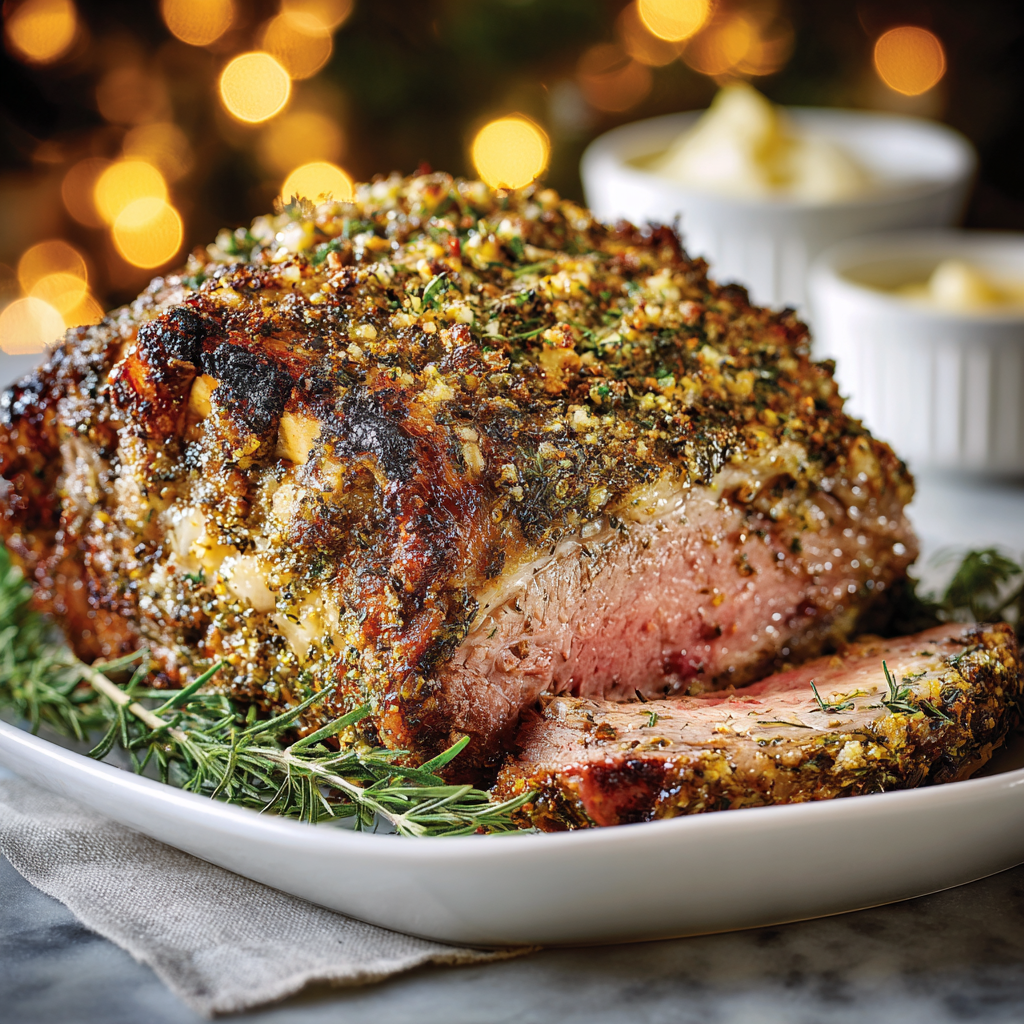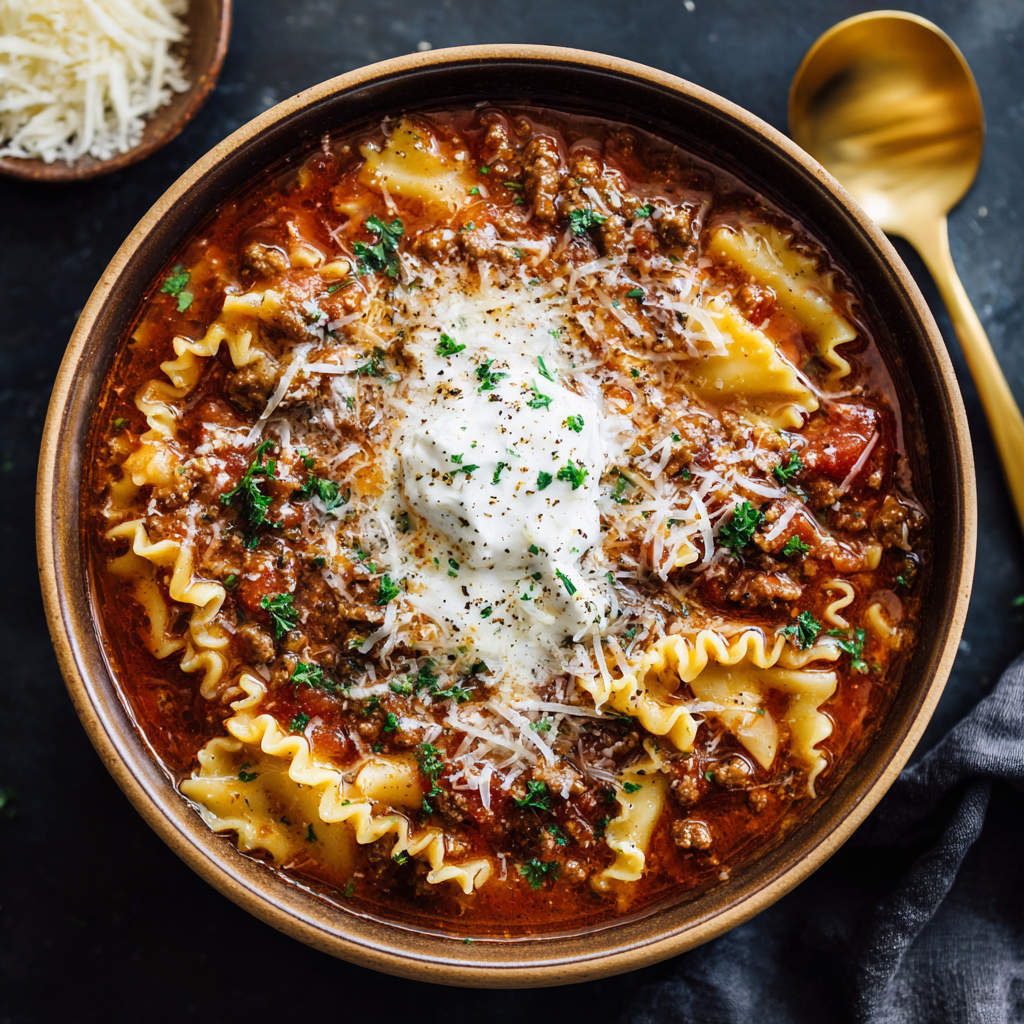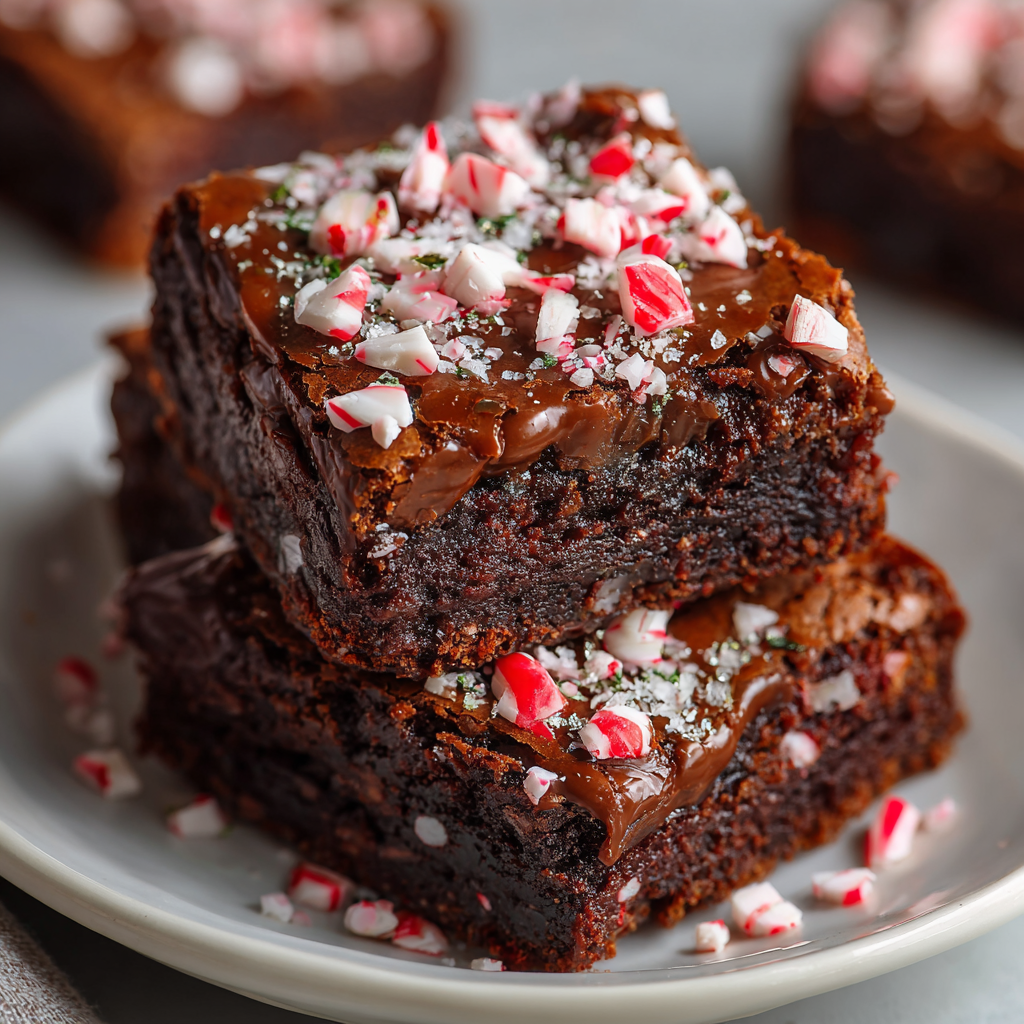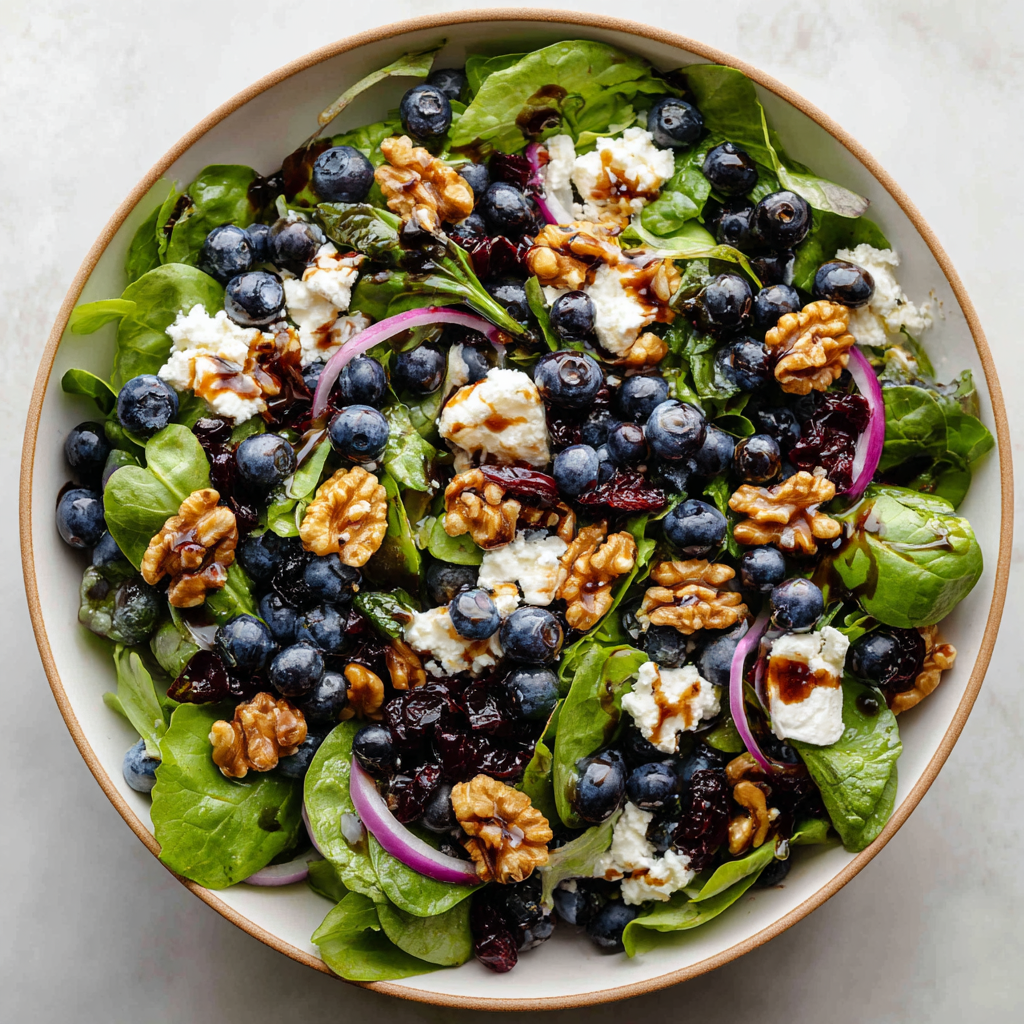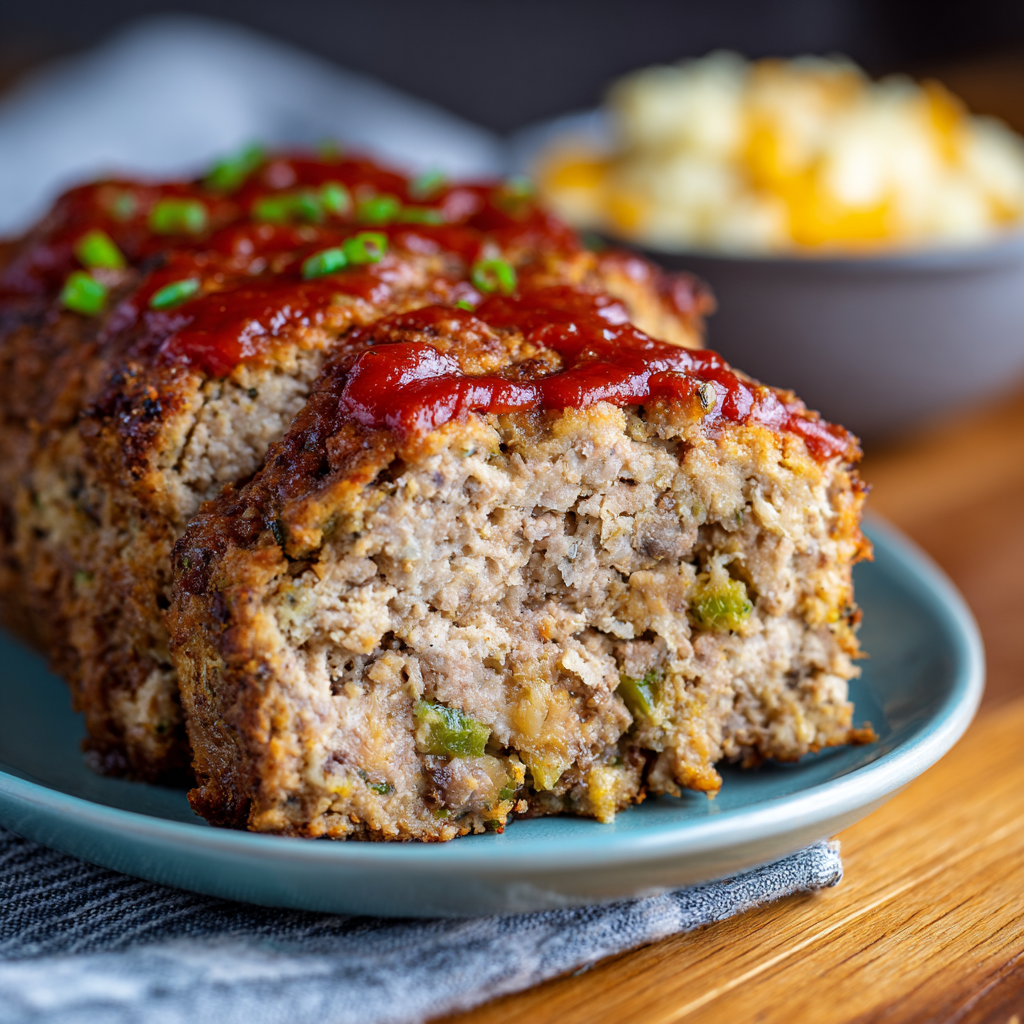The Garlic-Herb Crusted Prime Rib of Your Dreams Awaits
Hello, my friend, and welcome to my kitchen! Can you smell it? That intoxicating, savory, mouth-watering aroma of garlic, rosemary, and thyme slowly roasting with a beautiful cut of beef? It’s the scent of celebration, of gathering, of pure, unadulterated joy. If there’s one dish that has the power to turn a simple dinner into a legendary feast, it’s a perfectly cooked, Garlic-Herb Crusted Prime Rib.
I see you there, maybe feeling a little intimidated. That’s a big, beautiful, and let’s be honest, pricey piece of meat. The pressure feels real! But let me let you in on a little secret: this showstopper is actually one of the most forgiving and straightforward centerpieces you can make. The oven does almost all the work. Your job? To be the flavor conductor, the herb-applier, the confident chef who brings it all together.
This recipe is my ultimate holiday rockstar. It’s tender, it’s juicy, and it boasts a crust so packed with bold, savory flavor that your guests will be talking about it for weeks. We’re using a simple, powerful herb paste and a genius two-temperature cooking method that guarantees a crispy, crackling exterior and a perfectly pink, succulent interior from edge to edge. No more gray, overcooked beef! We’re creating magic here. So, tie on your favorite apron (the messy one with all the stories), preheat that oven, and let’s make a memory together.
A Prime Rib Story: My Grandfather’s Christmas Miracle
This recipe isn’t just a list of ingredients to me; it’s a living, breathing part of my family’s story. My most cherished prime rib memory takes me back to my grandfather’s house one snowy Christmas Eve. Papa Tony was a man of few words but immense, simmering love, and he expressed it all through food. That year, a blizzard was threatening to cancel our dinner, and the power flickered ominously.
Undaunted, Papa Tony stood guard by the oven like a captain at the helm of his ship. He’d mixed his herb paste with gnarled, experienced hands, telling me, “Olivia, the secret isn’t in the recipe, it’s in the patience.” As the storm raged outside, the warmth and that incredible garlicky-herb scent filled the entire house, becoming our beacon. When he finally pulled that majestic, crusty roast from the oven, the entire family gathered around, our worries forgotten. That first slice, revealing a perfect blush of pink, felt like a miracle. It taught me that the best meals aren’t just about feeding people; they’re about creating a sense of unwavering warmth and togetherness, no matter what’s happening outside. That’s the spirit I want you to capture with this dish.
Gathering Your Prime Rib A-Team: The Ingredients
Great cooking starts with great ingredients. Let’s break down this dream team and talk about why each one is crucial, plus some handy swaps if you’re in a pinch.
- 10 lbs beef prime rib (bone-in or boneless): This is our star! A bone-in roast will give you more flavor and juiciness (the bones act like a little internal flavor conductor), and it just looks spectacular on the table. Boneless is easier to carve. Choose a roast with a good cap of fat on top—that’s your flavor goldmine! Ask your butcher for a “standing rib roast” to get the right cut.
- 1 tbsp sea salt: We use a good amount of salt because we’re seasoning a large piece of meat. The coarse grains of sea salt create a delightful texture in the crust. Kosher salt works beautifully here too.
- 4 tsp black pepper: Freshly cracked is always best! It adds a gentle heat and pungency that complements the rich beef.
- 4 tsp fresh rosemary, chopped: Rosemary and beef are a match made in heaven. Its piney, robust flavor is essential. If you must use dried, use only 1 tsp, as dried herbs are more potent.
- 2 tsp fresh thyme, chopped: Thyme brings a subtle, earthy sweetness. I adore the tiny leaves of fresh thyme. Again, if using dried, scale back to ½ tsp.
- 12 garlic cloves, minced: Yes, twelve! This creates an incredible, aromatic crust. Don’t be shy. I use my microplane to mince it super fine so it melds perfectly into the paste.
- ½ cup olive oil: This is the base of our flavor-paste. It helps the herbs and garlic cling to the roast and promotes that beautiful, crispy browning. A regular olive oil is perfect here; no need for expensive extra virgin.
- Zest of 1 lemon (optional): My little chef’s hack! The zest doesn’t make it taste lemony, but it adds a touch of brightness that cuts through the richness of the beef and fat. Highly recommend!
- 1 tbsp Dijon mustard (optional): Another optional but brilliant addition. The mustard adds a subtle tang and helps the paste become a glue, ensuring the crust stays put.
- Horseradish or creamy sauce, for serving: A classic pairing! The sharp, pungent kick of horseradish cream is the perfect contrast to the rich, savory beef.
Your Foolproof Roadmap to Prime Rib Perfection
Ready to work some magic? Follow these steps, and you’ll be the hero of the dinner table. I’ve packed each one with my favorite tips and hacks to ensure your success.
- Bring to Room Temp: Take your prime rib out of the refrigerator about 1 hour before you plan to cook it. This is non-negotiable! A cold roast going into a hot oven will cook unevenly, leaving you with an overcooked outside and a cold center. Pat it dry thoroughly with paper towels—this is the secret to a super crispy crust, not a steamy one. While it’s resting, preheat your oven to a blazing 500°F (260°C).
- Make The Magical Herb Paste: In a medium bowl, combine the ½ cup olive oil, minced garlic, chopped rosemary, chopped thyme, sea salt, black pepper, lemon zest, and Dijon mustard. Mix it into a fragrant, glorious paste. Give it a taste—this is where you can adjust. Want more garlic? Go for it! This is your flavor profile.
- Season The Roast Like a Pro: Place your room-temp, dry roast in a roasting pan, preferably on a rack to allow for air circulation. Now, get messy! Using your hands (the best tools you have!), slather the herb paste all over the entire roast. Get the sides, the ends, and if you’re using a boneless roast, get it in the nooks and crannies. Don’t forget the bottom! You want every single bite to be infused with flavor.
- The High-Heat Sear: Place the roast in the preheated 500°F oven, fat-side up. Roast it uncovered for exactly 15 minutes. This initial blast of high heat is what creates that incredible, dark, crispy, flavor-packed crust we’re after. It’s the sear that locks in the juices. Don’t open the oven door! Trust the process.
- The Slow and Low Roast: After 15 minutes, without opening the door, reduce the oven temperature to 325°F (165°C). Let the roast continue to cook. Now, we’re gently bringing the inside to the perfect temperature. Cooking time will vary, but for a 10 lb roast, plan on 1.5 to 2 hours. THE MOST IMPORTANT TOOL HERE IS A MEAT THERMOMETER. I cannot stress this enough. Guesswork leads to disappointment. Insert the probe into the very center of the roast, avoiding any bones.
- Remove at 120°F for Rare
- Remove at 130°F for Medium Rare (this is the sweet spot for most people!)
- Remove at 140°F for Medium
Remember, the temperature will continue to rise about 5-10 degrees while resting (this is called “carryover cooking”).
- The Crucial Rest: This might be the hardest step, but it’s vital! Once your roast hits the target temperature, carefully remove it from the oven and transfer it to a cutting board. Tent it loosely with aluminum foil. Let it rest for a minimum of 30 minutes, but ideally for a full 60 minutes. I know, you want to slice into it! But resting allows the muscle fibers to relax and reabsorb all those incredible juices. If you slice it immediately, all the juices will run out onto the cutting board, leaving you with drier meat.
- Serve and Celebrate: After the rest, it’s time for the grand finale! If it’s bone-in, carefully slice the bones away from the bottom first, then slice the roast into thick, beautiful slabs. For a boneless roast, just slice straight across. Arrange on a warm platter and serve immediately with a big bowl of creamy horseradish sauce on the side. Get ready for the applause.
Setting the Stage: How to Serve Your Masterpiece
Presentation is part of the fun! I love placing the whole rested roast on a large wooden cutting board or a beautiful vintage platter. Pour any of those precious juices from the cutting board over the sliced meat for an extra glisten. Scatter some fresh rosemary sprigs and maybe a few halved lemons around the platter for a pop of color. Slice it thick—this is a generous, celebratory cut. Offer that zesty horseradish sauce in a small, pretty bowl right alongside it. This is a dish that deserves to be the undisputed star of the table.
Make It Your Own: Delicious Recipe Variations
Feel like playing with flavors? This prime rib is a fantastic canvas for your creativity!
- Coffee & Chili Rub: Add 1 tbsp of finely ground coffee and 1 tsp of chipotle chili powder to the herb paste for a deep, smoky, and slightly spicy twist.
- Mustard & Brown Sugar Glaze: Swap the Dijon for a whole-grain mustard and add 2 tbsp of brown sugar to the paste for a sweet and savory crust with incredible caramelization.
- Herbes de Provence: For a French-inspired twist, replace the rosemary and thyme with 2 tbsp of Herbes de Provence.
- Porcini Mushroom Crust: Grind ¼ cup of dried porcini mushrooms into a powder in a spice grinder and add it to the paste. It adds an unbelievable umami, earthy depth.
Chef’s Notes: From My Kitchen to Yours
This recipe has evolved so much over the years in my kitchen. The lemon zest was a happy accident one day when I was making a chicken and thought, “why not?” The Dijon mustard came from a desperate attempt to make a paste that would actually stick to the roast instead of sliding off. My biggest kitchen story? The year I was so busy chatting with family that I completely forgot to turn the oven down from 500°F! After 30 minutes of panic, we discovered that the exterior was extra crispy, but thanks to the massive size of the roast, the inside was still miraculously a perfect medium-rare. It just goes to show—even a “mistake” can turn into a happy discovery. Don’t stress. Cooking is an adventure. Embrace it, have fun, and know that a roast made with love is always a success.
Your Prime Rib Questions, Answered!
I’ve gotten thousands of questions on prime rib over the years. Here are the most common ones to set your mind at ease.
Q: Can I make the herb paste ahead of time?
A: Absolutely! You can mix the paste up to 24 hours in advance. Store it in an airtight container in the fridge. This actually allows the flavors to meld and become even more delicious.
Q: My herb crust is burning! What do I do?
A: If you notice the crust getting too dark during the slow-roast phase, simply tent the entire roast loosely with aluminum foil for the remainder of the cooking time. This will shield the crust from direct heat while allowing the inside to continue cooking gently.
Q: Why is my meat not as pink as I wanted?
A: This almost always comes down to one of two things: 1) The roast didn’t come to room temp before cooking, causing the inside to lag behind. Or 2) The most likely culprit: you used the clock and not a meat thermometer. Ovens vary wildly! That internal temperature is your only true guide. Invest in a good digital probe thermometer—it’s a game-changer.
Q: I have leftovers (lucky you!). What’s the best way to reheat them?
A: Please, I beg you, do not microwave prime rib! It will turn it rubbery. The best way is to reheat slices gently in a 250°F oven until just warm, about 10-15 minutes. You can also quickly sear a slice in a very hot, buttered cast-iron skillet for about 60-90 seconds per side. This keeps the inside medium-rare and the outside crispy.
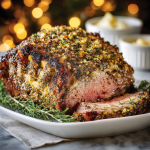
Garlic-Herb Crusted Prime Rib
Description
Tender, juicy, and topped with a flavorful garlic-herb crust, this prime rib is the ultimate centerpiece for holidays, special dinners, or any time you want to impress. The two-stage roasting method ensures a perfectly pink interior with a crispy, savory crust.
Ingredients
Prime Rib Roast:
-
10 lbs beef prime rib (bone-in or boneless, with fat cap)
-
1 tbsp sea salt
-
4 tsp freshly cracked black pepper
Garlic-Herb Paste:
-
4 tsp fresh rosemary, chopped (or 1 tsp dried)
-
2 tsp fresh thyme, chopped (or ½ tsp dried)
-
12 garlic cloves, minced
-
½ cup olive oil
-
Zest of 1 lemon (optional)
-
1 tbsp Dijon mustard (optional)
To Serve:
-
Horseradish or creamy sauce
Instructions
-
Bring to Room Temperature:
Remove roast from fridge 1 hour before cooking. Pat dry thoroughly. Preheat oven to 500°F (260°C). -
Make the Herb Paste:
In a bowl, combine olive oil, garlic, rosemary, thyme, salt, pepper, lemon zest, and mustard (if using). Mix to form a paste. -
Season the Roast:
Place roast on a rack in a roasting pan. Rub herb paste evenly over all sides. -
High-Heat Sear:
Roast at 500°F (260°C) for 15 minutes to create a crispy, flavorful crust. -
Slow Roast:
Reduce oven to 325°F (165°C) and continue roasting until internal temperature reaches:-
120°F for rare
-
130°F for medium-rare (recommended)
-
140°F for medium
Tip: Use a digital meat thermometer for accuracy.
-
-
Rest the Roast:
Remove from oven and tent with foil. Rest 30–60 minutes to let juices redistribute. -
Slice & Serve:
Slice roast thickly, arrange on a platter, and serve with horseradish or creamy sauce.
Notes
-
Make Ahead: Herb paste can be prepared 24 hours in advance; store in fridge.
-
Protect the Crust: Tent with foil if the crust browns too quickly during slow roast.
-
Flavor Twists:
-
Coffee & chili rub: add 1 tbsp ground coffee + 1 tsp chipotle powder.
-
Mustard & brown sugar glaze: swap Dijon for whole-grain mustard + 2 tbsp brown sugar.
-
Herbes de Provence: replace rosemary & thyme with 2 tbsp Herbes de Provence.
-
Porcini crust: add ¼ cup powdered dried porcini mushrooms to paste.
-
-
Reheating Leftovers: Avoid microwaving. Reheat slices gently in a 250°F oven for 10–15 minutes or sear in a hot skillet for 60–90 seconds per side.
Nutritional Information
Per serving (based on 18 servings):
Calories: 735 | Protein: 44g | Carbohydrates: 1g | Fat: 58g | Saturated Fat: 22g | Cholesterol: 156mg | Sodium:
Final Thoughts: You Are the Master of the Feast
So, there you have it. The mystery of the majestic prime rib, unraveled. That intimidating cut of meat has been transformed into an achievable, foolproof masterpiece waiting for you to create. Remember, the magic isn’t in complex techniques or secret ingredients—it’s in the simple, powerful combination of quality beef, a bold herb crust, and the trusting patience of a two-temperature roast.
This is more than a recipe; it’s a rite of passage. It’s the confidence to stand before a hungry table and present a dish that speaks of generosity, skill, and celebration. It’s the warmth of my grandfather’s kitchen, the joy of a gathered family, and the quiet pride of a cook who knows they’ve created something truly special.
So, take a deep breath, preheat that oven, and embrace your role as the hero of the holiday—or any Tuesday that deserves to feel legendary. That glorious, garlic-herb crusted prime rib of your dreams isn’t just waiting in a recipe; it’s waiting for you to bring it to life.

